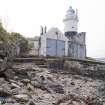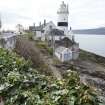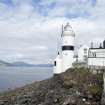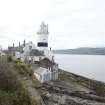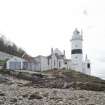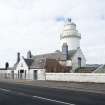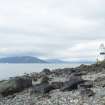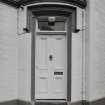Following the launch of trove.scot in February 2025 we are now planning the retiral of some of our webservices. Canmore will be switched off on 24th June 2025. Information about the closure can be found on the HES website: Retiral of HES web services | Historic Environment Scotland
Inverkip, The Cloch Lighthouse
Lighthouse (18th Century)
Site Name Inverkip, The Cloch Lighthouse
Classification Lighthouse (18th Century)
Alternative Name(s) Cloch Point; 'the Clogh'; Cloch Lighthouse; Inner Clyde Estuary; Inner Firth Of Clyde
Canmore ID 123013
Site Number NS27NW 16
NGR NS 20319 75877
Datum OSGB36 - NGR
Permalink http://canmore.org.uk/site/123013
- Council Inverclyde
- Parish Inverkip
- Former Region Strathclyde
- Former District Inverclyde
- Former County Renfrewshire
NS27NW 16 20319 75877
Cloch Lighthouse [NAT]
OS 1:10,000 map, 1990.
For Cloch Point [coast defence] battery (NS 2050 7585), see NS27NW 21.00.
Built by James Clarkson, 1797, the lantern being supplied by Thomas Smith.
D B Hague and R Christie 1975.
(Location cited as NS 203 758). Cloch Lighthouse, built 1797. A short circular-section tower with corbelled walkway and triangular windows. There appear to be two generations of keepers' houses, the older now used as stores and the more recent having crow-stepped gables.
J R Hume 1976.
The light at the 'Clogh' was built in 1795-7 by John Clarkson (engineer); Kermack and Gall built the tower while Smith and Stevenson installed the (oil) lantern which was first lit on 11 August 1797. The light was 'completely renewed' in 1829 when an argand light and silvered reflector were installed. Two whistles with differently-pitched notes were installed after 1865; the light was experimentally lit with acetylene about 1900 and a radio 'talikng beacon' installed about 1931.
R W Munro 1979.
This lighthouse is situated low down on the E shore of the Firth of Clyde and a short distance SW of Cloch Point [name: NS 205 760], where ships turn eastward into the inner firth.
Information from RCAHMS (RJCM), 27 February 2006.
Ancilliary buildings to Robert Stevenson, Engineer (Thomas Smith (Engineer in charge) Cloch Lighthouse.
Construction (1795 - 1797)
The light at the 'Clogh' was built in 1795-7 by John Clarkson (engineer); Kermack and Gall built the tower while Smith and Stevenson installed the (oil) lantern which was first lit on 11 August 1797.
R W Munro 1979
Publication Account (1985)
The Cloch is one of the three lighthouses built to protect the difficult waters at the head of the Firth of Clyde, the other two being on Little Cumbrae and at Toward Point, Cowal. Increased traffic on the Clyde in the later 18th century led to demands from Glasgow shipowners for more lights on the river; consequently, in 1795 Cloch Point was chosen as 'unquestionably the most proper situation' and the light was first shown on 11th August 1797. A Greenock river pilot, Allan McLean, was selected as the first keeper at a salary of £30 p.a. and, besides his duties as a keeper, he was allowed to continue to act as a pilot, so long as this did not interfere with his other duties.
The lighthouse was built by Kermack and Gall; it consists of a short, round tower with corbelled walkways, and it is now accompanied by two sets of keepers' houses. The earlier houses are used as stores and the later are easily identified by their crowstepped gables.
Information from ‘Exploring Scotland’s Heritage: The Clyde Estuary and Central Region’, (1985).
Note (27 February 2006)
This lighthouse is situated low down on the E shore of the Firth of Clyde and a short distance SW of Cloch Point [name: NS 205 760], where ships turn eastward into the inner firth.
Information from RCAHMS (RJCM), 27 February 2006.
Project (2007)
This project was undertaken to input site information listed in 'Civil engineering heritage: Scotland - Lowlands and Borders' by R Paxton and J Shipway, 2007.
Publication Account (2007)
The first light at Cloch Lighthouse was installed on its completion in 1797 by Robert Stevenson acting for the
Cumbrae Lighthouse Trust’s engineer Thomas Smith. This was four years after the present lighthouse on Little
Cumbrae had been modernised by the Trust.
Cloch light was improved in 1825 and 1903 and, by means of a wireless innovation by C. & D. A. Stevenson
in 1930 which attracted a Royal Society of Arts award, became a talking lighthouse in poor visibility. The light is
no longer used and the building is now a private residence. Ships now use a buoyed channel.
In the 19th century the distance between Cloch and Little Cumbrae lighthouses was used for speed trials. The
practice of ‘Running the Lights’ became an event on the Clyde for any new steamer, and a fast ship could run the Cloch distance of approximately 16 miles in 48 minutes (17.4 knots).
R Paxton and J Shipway
Reproduced from 'Civil Engineering heritage: Scotland - Lowlands and Borders' with kind permission of Thomas Telford Publishers.






























































